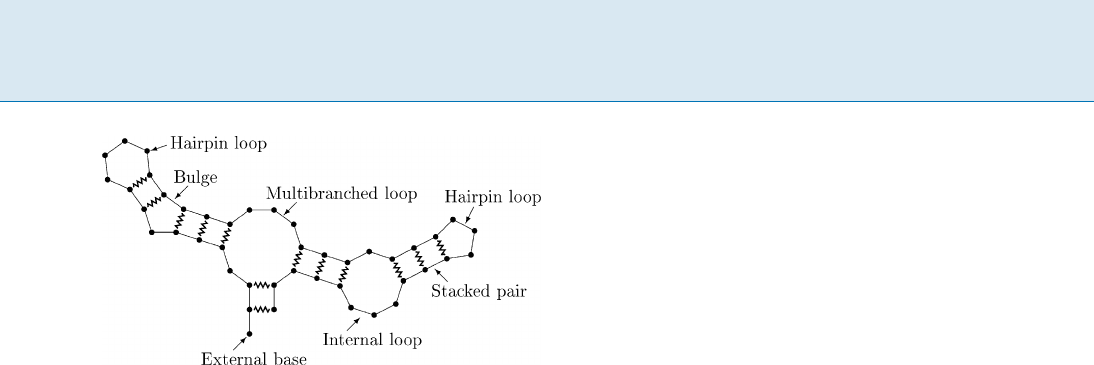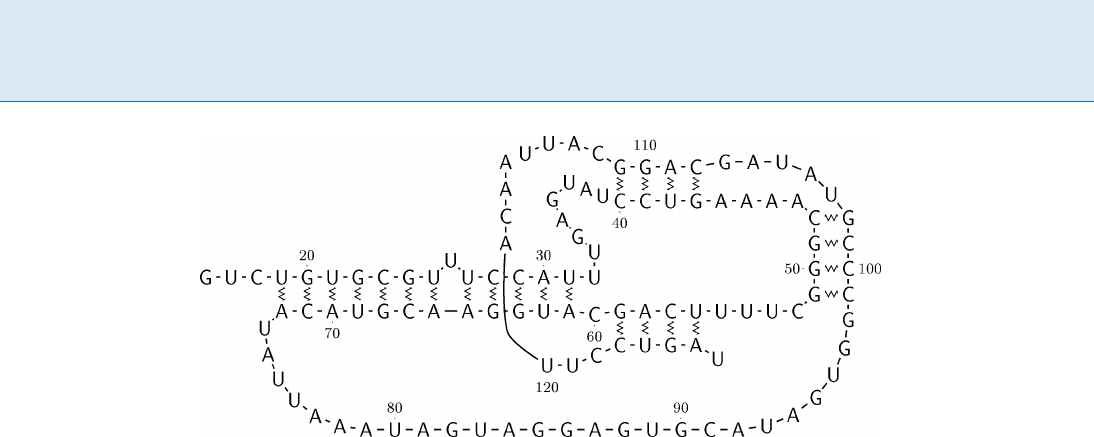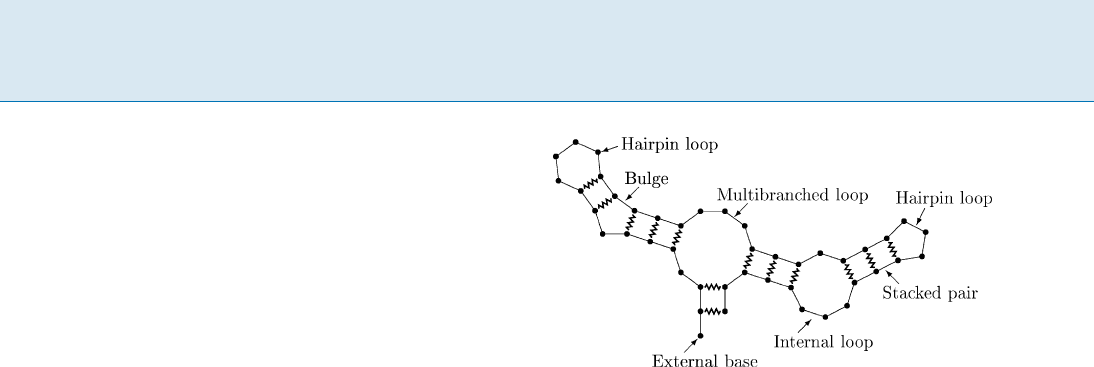Kao M.-Y. (ed.) Encyclopedia of Algorithms
Подождите немного. Документ загружается.


778 R RNA Secondary Structure Boltzmann Distribution
RNA Secondary Structure Boltzmann Distribution, Figure 1
A hypothetical RNA structure illustrating the different loop
types. Bases are represented by circles,theRNAbackboneby
straight lines, and base pairs by zigzagged lines
structure only depends on the secondary structure, and
that this in turn can be broken into a sum of independent
contributions from each loop in the secondary structure.
Definition 2 (Loops) For i j 2
S,basek is accessible
from i j iff i < k < j and :9i
0
j
0
2 S: i < i
0
< k <
j
0
< j.Theloop closed by i j;`
ij
, consists of i j and all
thebasesaccessiblefromi j.Ifi
0
j
0
2 S and i
0
and j
0
are
accessible from i j,theni
0
j
0
is an interior base pair in
the loop closed by i j.
Loops are classified by the number of interior base pairs
they contain:
hairpin loops have no interior base pairs
stacked pairs, bulges, and internal loops have one in-
terior base pair that is separated from the closing base
pair on neither side, on one side, or on both sides, re-
spectively
multibranched loops have two or more interior base
pairs
Bases not accessible from any base pair are called external.
This is illustrated in Fig. 1. The free energy of structure
S
is
G(
S)=
X
ij2S
G(`
ij
)(2)
where G(`
ij
) is the free energy contribution from the
loop closed by i j. The contribution of
S to the full parti-
tion function is
e
G(S)/RT
=e
P
ij2S
G
(
`
ij
)
/RT
=
Y
`
ij
2S
e
G
(
`
ij
)
/RT
:
(3)
Problem 1 (RNA Secondary Structure Distribution)
I
NPUT: RNA sequence s, absolute temperature T and speci-
fication of G at T for all loops.
O
UTPUT:
P
S
e
G(S)/RT
, where the sum is over all sec-
ondary structures for s.
Key Results
Solutions are based on recursions similar to those for RNA
Secondary Structure Prediction by Minimum Free Energy,
replacing sum and minimization with multiplication and
sum (or more generally with a merge function and a choice
function [8]). The key difference is that recursions are re-
quired to be non-redundant, i. e. any particular secondary
structure only contributes through one path through the
recursions.
Theorem 1 Using the standard thermodynamic model
for RNA secondary structures, the partition function can
be computed in time O(|s|
3
) and space O(|s|
2
). More-
over, the computation can build data structures that al-
low O(1) queries of the pairing probability of i jforany
1 i < j jsj [5,6,7].
Theorem 2 Using the standard thermodynamic model for
RNA secondary structures, the expectation and variance of
free energy over the Boltzmann distribution can be com-
puted in time O(|s|
3
) and space O(|s|
2
). More generally, the
kth moment
E
Boltzmann
[G]=1/Z
X
S
e
G(S)/RT
G
k
(S) ; (4)
where Z =
P
S
e
G(S)/RT
is the full partition function and
the sums are over all secondary structures for s, can be com-
puted in time O(k
2
|s|
3
)andspaceO(k|s|
2
)[8].
In Theorem 2 the free energy does not hold a special place.
The theorem holds for any function ˚ defined by an inde-
pendent contribution from each loop,
˚(
S)=
X
ij2S
`
ij
; (5)
provided each loop contribution can be handled with the
same efficiency as the free energy contributions. Hence,
moments over the Boltzmann distribution of e. g. num-
ber of base pairs, unpaired bases, or loops can also be ef-
ficiently computed by applying appropriately chosen indi-
cator functions.
Applications
The original use of partition function computations was
for discriminating between well defined and less well de-
fined regions of a secondary structure. Minimum free en-
ergy predictions will always return a structure. Base pair-
ing probabilities help identify regions where the predic-
tion is uncertain, either due to the approximations of the

RNA Secondary Structure Boltzmann Distribution R 779
model or that the real structure indeed does fluctuate be-
tween several low energy alternatives. Moments of Boltz-
mann distributions are used in identifying how biological
RNA molecules deviates from random RNA sequences.
The data structures computed in Theorem 1 can also
be used to efficiently sample secondary structures from the
Boltzmann distribution. This has been used for probabilis-
tic methods for secondary structure prediction, where the
centroid of the most likely cluster of sampled structures is
returned rather than the most likely, i. e. minimum free en-
ergy, structure [3]. This approach better accounts for the
entropic effects of large neighborhoods of structurally and
energetically very similar structures. As a simple illustra-
tion of this effect, consider twice flipping a coin with prob-
ability p > 0:5 for heads. The probability p
2
of heads in
both flips is larger than the probability p(1 p)ofheads
followed by tails or tails followed by heads (which again is
larger than the probability (1 p)
2
of tails in both flips).
However, if the order of the flips is ignored the probabil-
ity of one heads and one tails is 2p(1 p). The probability
of two heads remains p
2
which is smaller than 2p(1 p)
when p <
2
3
. Similarly a large set of structures with fairly
low free energy may be more likely, when viewed as a set,
than a small set of structures with very low free energy.
Open Problems
As for RNA Secondary Structure Prediction by Minimum
Free Energy, improvements in time and space complexity
are always relevant. This may be more difficult for comput-
ing distributions, as the more efficient dynamic program-
ming techniques of [9]cannotbeapplied.Inthecontext
of genome scans, the fact that the start and end positions
of encoded RNA molecule is unknown has recently been
considered [1].
Also the problem of including structures with pseu-
doknots, i. e. structures violating the last requirement in
Def. 1, in the configuration space is an active area of re-
search. It can be expected that all the methods of Theo-
rems3through6intheentryonRNASecondaryStruc-
ture Prediction Including Pseudoknots can be modified to
computation of distributions without affecting complexi-
ties. This may require some further bookkeeping to ensure
non-redundancy of recursions, and only in [4] has this ac-
tively been considered.
Though the moments of functions that are defined as
sums over independent loop contributions can be com-
puted efficiently, it is unknown whether the same holds for
functions with more complex definitions. One such func-
tion that has traditionally been used for statistics on RNA
secondary structure [12]istheorder of a secondary struc-
ture which refers to the nesting depth of multibranched
loops.
URL to Code
Software for partition function computation and a range
of related problems is available from www.bioinfo.rpi.edu/
applications/hybrid/download.php and www.tbi.univie.
ac.at/~ivo/RNA/. Software including a restricted class of
structures with pseudoknots [4] is available at www.
nupack.org.
Cross References
RNA Secondary Structure Prediction Including
Pseudoknots
RNA Secondary Structure Prediction by Minimum
Free Energy
Recommended Reading
1. Bernhart, S., Hofacker, I.L., Stadler, P.: Local RNA base pairing
probabilities in large sequences. Bioinformatics 22, 614–615
(2006)
2. Bernhart,S.H.,Tafer,H.,Mückstein,U.,Flamm,C.,Stadler,P.F.,
Hofacker, I.L.: Partition function and base pairing probabilities
of RNA heterodimers. Algorithms Mol. Biol. 1, 3 (2006)
3. Ding, Y., Chan, C.Y., Lawrence, C.E.: RNA secondary structure
prediction by centroids in a Boltzmann weighted ensemble.
RNA 11, 1157–1166 (2005)
4. Dirks, R.M., Pierce, N.A.: A partition function algorithm for nu-
cleic acid secondary structure including pseudoknots. J. Com-
put. Chem. 24, 1664–1677 (2003)
5. Hofacker, I.L., Stadler, P.F.: Memory efficient folding algorithms
for circular RNA secondary structures. Bioinformatics 22,1172–
1176 (2006)
6. Lyngsø, R.B., Zuker, M., Pedersen, C.N.S.: Fast evaluation of in-
ternal loops in RNA secondary structure prediction. Bioinfor-
matics 15, 440–445 (1999)
7. McCaskill, J.S.: The equilibrium partition function and base pair
binding probabilities for RNA secondary structure. Biopoly-
mers 29, 1105–1119 (1990)
8. Miklós, I., Meyer, I.M., Nagy, B.: Moments of the Boltzmann dis-
tribution for RNA secondary structures. Bull. Math. Biol. 67,
1031–1047 (2005)
9. Ogurtsov, A.Y., Shabalina, S.A., Kondrashov, A.S., Roytberg,
M.A.: Analysis of internal loops within the RNA secondary struc-
ture in almost quadratic time. Bioinformatics 22, 1317–1324
(2006)
10. Tinoco, I., Borer, P.N., Dengler, B., Levine, M.D., Uhlenbeck, O.C.,
Crothers, D.M., Gralla, J.: Improved estimation of secondary
structure in ribonucleic acids. Nature New Biol. 246, 40–41
(1973)
11. Tinoco, I., Uhlenbeck, O.C., Levine, M.D.: Estimation of sec-
ondary structure in ribonucleic acids. Nature 230, 362–367
(1971)
12. Waterman, M.S.: Secondary structure of single-stranded nu-
cleic acids. Adv. Math. Suppl. Stud. 1, 167–212 (1978)

780 R RNA Secondary Structure Prediction Including Pseudoknots
RNA Secondary Structure Prediction
Including Pseudoknots
2004; Lyngsø
RUNE B. LYNGSØ
Department of Statistics, Oxford University, Oxford, UK
Keywords and Synonyms
Abbreviated as Pseudoknot Prediction
Problem Definition
This problem is concerned with predicting the set of base
pairsformedinthenativestructureofanRNAmolecule,
including overlapping base pairs also known as pseudo-
knots. Standard approaches to RNA secondary structure
prediction only allow sets of base pairs that are hierarchi-
cally nested. Though few known real structures require the
removal of more than a small percentage of their base pairs
to meet this criteria, a significant percentage of known real
structures contain at least a few base pairs overlapping
other base pairs. Pseudoknot substructures are known to
be crucial for biological function in several contexts. One
of the more complex known pseudoknot structures is il-
lustrated in Fig. 1
Notation
Let s 2fA; C; G; Ug
denote the sequence of bases of an
RNA molecule. Use X Y where X; Y 2fA; C; G; Ug to
denote a base pair between bases of type X and Y,andi j
where 1 i < j jsjto denote a base pair between bases
s[i]ands[j].
Definition 1 (RNA Secondary Structure) Asecondary
structure for an RNA sequence s is a set of base pairs
S = fi j j 1 i < j jsj^i < j 3g.Fori j; i
0
j
0
2 S
with i j ¤ i
0
j
0
fi; jg\fi
0
; j
0
g = ; (each base pairs with at most one
other base)
fs[i]; s[j]g2
f
fA; Ug; fC; Gg; fG; Ug
g
(only Watson-
Crick and G; U wobble base pairs)
The second requirement, that only canonical base pairs are
allowed, is standard but not consequential in solutions to
the problem.
Scoring Schemes
Structures are usually assessed by extending the model of
Gibbs free energy used for RNA Secondary Structure Pre-
diction by Minimum Free Energy (cf. corresponding en-
try) with ad hoc extrapolation of multibranched loop ener-
gies to pseudoknot substructures [11], or by summing in-
dependent contributions e. g. obtained from base pair re-
stricted minimum free energy structures from each base
pair [13]. To investigate the complexity of pseudoknot
prediction the following three simple scoring schemes will
also be considered:
Number of Base Pairs,
#BP(
S)=
j
S
j
Number of Stacking Base Pairs
#SBP(
S)=
j
fi j 2S j i +1 j 12S_ i 1 j +12Sg
j
Number of Base Pair Stackings
#BPS(
S)=
j
fi j 2 S j i +1 j 1 2 Sg
j
These scoring schemes are inspired by the fact that
stacked pairs are essentially the only loops having a sta-
bilizing contribution in the Gibbs free energy model.
Problem 1 (Pseudoknot Prediction)
I
NPUT: RNA sequence s and an appropriately specified scor-
ing scheme.
O
UTPUT: A secondary structure S for s that is optimal un-
der the scoring scheme specified.
Key Results
Theorem 1 The complexities of pseudoknot prediction un-
der the three simplified scoring schemes can be classified as
follows, where ˙ denotes the alphabet.
Fixed alphabet Unbounded alphabet
#BP [13] Time O
jsj
3
,
space O
jsj
2
Time O
jsj
3
,
space O
jsj
2
#SBP [7] Time
O
jsj
1+j˙j
2
+j˙j
3
,
space O
jsj
j˙j
2
+j˙j
3
NP hard
#BPS NP hard for j˙j =2,
PTAS [7]
1/3-approximation
in time O
jsj
[6]
NP hard [7],
1/3-approximation
in time and space O
jsj
2
[6]
Theorem 2 If structures are restricted to be planar, i. e. the
graph with the bases of the sequence as nodes and base
pairs and backbone links of consecutive bases as edges is re-
quired to be planar, pseudoknot prediction under the #BPS
scoring scheme is NP hard for an alphabet of size 4. Con-
versely, a 1/2-approximation can be found in time O
jsj
3

RNA Secondary Structure Prediction Including Pseudoknots R 781
RNA Secondary Structure Prediction Including Pseudoknots, Figure 1
Secondary structure of the Escherichia coli ˛ operon mRNA from position 16 to position 127, cf. [5], Figure 1. The backbone of the
RNA molecule is drawn as straight lines while base pairings are shown with zigzagged lines
and space O
jsj
2
by observing that an optimal pseudoknot
free structure is a 1/2-approximation [6].
There are no steric reasons that RNA secondary structures
should be planar, and the structure in Fig. 1 is actually
non-planar. Nevertheless, known real structures have rel-
atively simple overlapping base pair patterns with very few
non-planar structures known. Hence, planarity has been
used as a defining restriction on pseudoknotted struc-
tures [2,15]. Similar reasoning has lead to development of
several algorithms for finding an optimal structure from
restricted classes of structures. These algorithms tend to
use more realistic scoring schemes, e. g. extensions of the
Gibbs free energy model, than the three simple scoring
schemes considered above.
Theorem 3 Pseudoknot prediction for a restricted class of
structures including Fig. 2a through Fig. 2e, but not Fig. 2f,
can be done in time O
jsj
6
and space O
jsj
4
[11].
Theorem 4 Pseudoknot prediction for a restricted class of
planar structures including Fig. 2a through Fig. 2c, but not
Fig. 2d through Fig. 2f,canbedoneintimeO
jsj
5
and
space O
jsj
4
[14].
Theorem 5 Pseudoknot prediction for a restricted class
of planar structures including Fig. 2aandFig.2b, but not
Fig. 2c through Fig. 2f,canbedoneintimeO
jsj
5
and
space O
jsj
4
or O
jsj
3
[1,4] (methods differ in generality
of scoring schemes that can be used).
Theorem 6 Pseudoknot prediction for a restricted class of
planar structures including Fig. 2a, but not Fig. 2bthrough
Fig. 2f,canbedoneintimeO
jsj
4
and space O
jsj
2
[1,8].
Theorem 7 Recognition of structures belonging to the re-
stricted classes of Theorems 3, 5, and 6, and enumeration
of all irreducible cycles (i. e. loops) in such structures can be
done in time O
(
jsj
)
[3,9].
Applications
As for the prediction of RNA secondary structures with-
out pseudoknots, the key application of these algorithms
are for predicting the secondary structure of individual
RNA molecules. Due to the steep complexities of the algo-
rithms of Theorems 3 through 6, these are less well suited
for genome scans than prediction without pseudoknots.
Enumerating all loops of a structure in linear time also
allows scoring a structure in linear time, as long as the
scoring scheme allows the score of a loop to be computed
in time proportional to its size. This has practical applica-
tions in heuristic searches for good structures containing
pseudoknots.
Open Problems
Efficient algorithms for prediction based on restricted
classes of structures with pseudoknots that still contain
a significant fraction of all known structures is an active
area of research. Even using the more theoretical simple
#SBP scoring scheme, developing e. g. an O
jsj
j˙j
algo-
rithm for this problem would be of practical significance.
From a theoretical point of view, the complexity of planar
structures is the least well understood, with results for only
the #BPS scoring scheme.
Classification of and realistic energy models for RNA
secondary structures with pseudoknots are much less de-
veloped than for RNA secondary structures without pseu-
doknots. Several recent papers have been addressing this
gap [3,9,12].

782 R RNA Secondary Structure Prediction by Minimum Free Energy
RNA Secondary Structure Prediction Including Pseudoknots, Figure 2
RNA secondary structures illustrating restrictions of pseudoknot prediction algorithms. Backbone is drawn as a straight line while
base pairings are shown with zigzagged arcs
Data Sets
PseudoBase at http://biology.leidenuniv.nl/~batenburg/
PKB.html is a repository of representatives of most known
RNA structures with pseudoknots.
URL to Code
The method of Theorem 3 is available at http://selab.
janelia.org/software.html#pknots,ofoneofthemethods
of Theorem 5 at http://www.nupack.org,andanimple-
mentation applying a slight heuristic reduction of the
class of structures considered by the method of Theo-
rem 6 is available at http://bibiserv.techfak.uni-bielefeld.
de/pknotsrg/ [10].
Cross References
RNA Secondary Structure Prediction by Minimum
Free Energy
Recommended Reading
1. Akutsu, T.: Dynamic programming algorithms for RNA sec-
ondary structure prediction with pseudoknots. Discret. Appl.
Math. 104, 45–62 (2000)
2. Brown, M., Wilson, C.: RNA pseudoknot modeling using inter-
sections of stochastic context free grammars with applications
to database search. In: Hunter, L., Klein, T. (eds.) Proceedings
of the 1st Pacific Symposium on Biocomputing, 1996, pp. 109–
125
3. Condon,A.,Davy,B.,Rastegari,B.,Tarrant,F.,Zhao,S.:Classi-
fying RNA pseudoknotted structures. Theor. Comput. Sci. 320,
35–50 (2004)
4. Dirks, R.M., Pierce, N.A.: A partition function algorithm for nu-
cleic acid secondary structure including pseudoknots. J. Com-
put. Chem. 24, 1664–1677 (2003)
5. Gluick, T.C.,Draper, D.E.: Thermodynamics of folding a pseudo-
knotted mRNA fragment. J. Mol. Biol. 241, 246–262 (1994)
6. Ieong,S.,Kao,M.-Y.,Lam,T.-W.,Sung,W.-K.,Yiu,S.-M.:Pre-
dicting RNA secondary structures with arbitrary pseudoknots
by maximizing the number of stacking pairs. In: Proceedings
of the 2nd Symposium on Bioinformatics and Bioengineering,
2001, pp. 183–190
7. Lyngsø, R.B.: Complexity of pseudoknot prediction in simple
models. In: Proceedings of the 31th International Colloquium
on Automata, Languages and Programming (ICALP), 2004,
pp. 919–931
8. Lyngsø, R.B., Pedersen, C.N.S.: RNA pseudoknot prediction in
energy based models. J. Comput. Biol. 7, 409–428 (2000)
9. Rastegari, B., Condon, A.: Parsing nucleic acid pseudoknotted
secondary structure: algorithm and applications. J. Comput.
Biol. 14(1), 16–32 (2007)
10. Reeder, J., Giegerich, R.: Design, implementation and evalu-
ation of a practical pseudoknot folding algorithm based on
thermodynamics. BMC Bioinform. 5, 104 (2004)
11. Rivas, E., Eddy, S.: A dynamic programming algorithm for RNA
structure prediction including pseudoknots. J. Mol. Biol. 285,
2053–2068 (1999)
12. Rødland, E.A.: Pseudoknots in RNA secondary structure: Rep-
resentation, enumeration, and prevalence. J. Comput. Biol. 13,
1197–1213 (2006)
13. Tabaska, J.E., Cary, R.B., Gabow, H.N., Stormo, G.D.: An RNA
folding method capable of identifying pseudoknots and base
triples. Bioinform. 14, 691–699 (1998)
14. Uemura, Y., Hasegawa, A., Kobayashi, S., Yokomori, T.: Tree ad-
joining grammars for RNA structure prediction. Theor. Com-
put. Sci. 210, 277–303 (1999)
15. Witwer, C., Hofacker, I.L., Stadler, P.F.: Prediction of consensus
RNA secondary structures including pseudoknots. IEEE Trans.
Comput. Biol. Bioinform. 1, 66–77 (2004)
RNA Secondary Structure Prediction
by Minimum Free Energy
2006; Ogurtsov, Shabalina, Kondrashov,
Roytberg
RUNE B. LYNGSØ
Department of Statistics, Oxford University, Oxford, UK

RNA Secondary Structure Prediction by Minimum Free Energy R 783
Keywords and Synonyms
RNA Folding
Problem Definition
This problem is concerned with predicting the set of base
pairs formed in the native structure of an RNA molecule.
The main motivation stems from structure being cru-
cial for function and the growing appreciation of the im-
portance of RNA molecules in biological processes. Base
pairing is the single most important factor determining
structure formation. Knowledge of the secondary struc-
ture alone also provides information about stretches of
unpaired bases that are likely candidates for active sites.
Early work [7] focused on finding structures maximiz-
ing the number of base pairs. With the work of Zuker
and Stiegler [17] focus shifted to energy minimization in
a model approximating the Gibbs free energy of struc-
tures.
Notation
Let s 2fA; C; G; Ug
denote the sequence of bases of an
RNA molecule. Use X Y where X; Y 2fA; C; G; Ug to
denote a base pair between bases of type X and Y,andi j
where 1 i < j jsjto denote a base pair between bases
s[i]ands[j].
Definition 1 (RNA Secondary Structure) Asec-
ondary structure for an RNA sequence s is a set
of base pairs
S = fi j j 1 i < j jsj^i < j 3g.For
i j; i
0
j
0
2 S with i j ¤ i
0
j
0
fi; jg\fi
0
; j
0
g = ; (each base pairs with at most one
other base)
fs[i]; s[j]g2
f
fA; Ug; fC; Gg; fG; Ug
g
(only Watson-
Crick and G; U wobble base pairs)
i < i
0
< j ) j
0
< j (base pairs are either nested or jux-
taposed but not overlapping).
The second requirement, that only canonical base pairs are
allowed, is standard but not consequential in solutions to
the problem. The third requirement states that the struc-
ture does not contain pseudoknots. This restriction is cru-
cial for the results listed in this entry.
Energy Model
The model of Gibbs free energy applied, usually referred
to as the nearest-neighbor model, was originally proposed
by Tinoco et al. [10,11]. It approximates the free energy by
postulating that the energy of the full three dimensional
structure only depends on the secondary structure, and
RNA Secondary Structure Prediction by Minimum Free Energy,
Figure 1
A hypothetical RNA structure illustrating the different loop
types. Bases are represented by circles,theRNAbackboneby
straight lines, and base pairs by zigzagged lines
that this in turn can be broken into a sum of indepen-
dent contributions from each loop in the secondary struc-
ture.
Definition 2 (Loops) For ij 2
S,basek is accessible from
i j iff i < k < j and :9i
0
j
0
2 S : i < i
0
< k < j
0
< j.
The loop closed by i j;`
ij
, consists of i j and all the bases
accessible from i j.Ifi
0
j
0
2 S and i
0
and j
0
are accessible
from i j,theni
0
j
0
is an interior base pair in the loop
closed by i j.
Loops are classified by the number of interior base pairs
they contain:
hairpin loops have no interior base pairs
stacked pairs, bulges, and internal loops have one in-
terior base pair that is separated from the closing base
pair on neither side, on one side, or on both sides, re-
spectively
multibranched loops have two or more interior base
pairs.
Bases not accessible from any base pair are called external.
This is illustrated in Fig. 1. The free energy of structure
S
is
´G(
S)=
X
ij2S
´G(`
ij
) ; (1)
where ´G(`
ij
) is the free energy contribution from the
loop closed by i j.
Problem 1 (Minimum Free Energy Structure)
I
NPUT: RNA sequence s and specification of ´G for all loops.
O
UTPUT: arg min
S
f
´G(
S) j S secondary structure for s
g
.

784 R RNA Secondary Structure Prediction by Minimum Free Energy
Key Results
Solutions are based on using dynamic programming to
solve the general recursion
V[i; j]= min
k0;i<i
1
< j
1
<:::<i
k
< j
k
< j
(
G(`
ij;i
1
j
1
;:::;i
k
j
k
)
+
k
X
l=1
V[i
l
; j
l
]
)
W[i]=min
W[i 1]; min
0<k<i
f
W[k 1] + V[k; i]
g
;
where ´G(`
ij;i
1
j
1
;:::;i
k
j
k
) is the free energy of the loop
closed by i j and interior base pairs i
1
j
1
;:::;i
k
j
k
and
with initial condition W[0] = 0. In the following it is as-
sumed that all loop energies can be computed in time O(1).
Theorem 1 If the free energy of multibranched loops is
asumof
an affine function of the number of interior base pairs
and unpaired bases
contributions for each base pair from stacking with ei-
ther neighboring unpaired bases in the loop or with
a neighboring base pair in the loop, whichever is more
favorable,
a minimum free energy structure can be computed in time
O(jsj
4
) and space O(jsj
2
)[17].
With these assumptions the time required to handle the
multibranched loop parts of the recursion reduces to
O(jsj
3
). Hence handling the O(jsj
4
) possible internal loops
becomes the bottleneck.
Theorem 2 If furthermore the free energy of internal loops
is a sum of
a function of the total size of the loop, i. e. the number of
unpaired bases in the loop,
a function of the asymmetry of the loop, i. e. the differ-
ence in number of unpaired bases on the two sides of the
loop,
contributions from the closing and interior base pairs
stacking with the neighboring unpaired bases in the loop,
a minimum free energy structure can be computed in time
O(jsj
3
) and space O(jsj
2
)[5].
Under these assumptions the time required to handle in-
ternal loops reduces to O(jsj
3
). With further assumptions
on the free energy contributions of internal loops this can
be reduced even further, again making the handling of
multibranched loops the bottleneck of the computation.
Theorem 3 If furthermore the size dependency is con-
cave and the asymmetry dependency is constant for all but
O(1) values, a multibranched loop free minimum free en-
ergy structure can be computed in time O(jsj
2
log
2
jsj) and
space O(jsj
2
)[8].
The above assumptions are all based on the nature of
current loop energies [6]. These energies have to a large
part been developed without consideration of computa-
tional expediency and parameters determined experimen-
tally, although understanding of the precise behavior of
larger loops is limited. For multibranched loops some the-
oretical considerations [4] would suggest that a logarith-
mic dependency would be more appropriate.
Theorem 4 If the restriction on the dependency on num-
ber of interior base pairs and unpaired bases in Theorem 1
is weakened to any function that depends only on the num-
ber of interior base pairs, the number of unpaired bases,
or the total number of bases in the loop, a minimum free
energy structure can be computed in time O(n
4
)andspace
O(n
3
) [13].
Theorem 5 All the above theorems can be modified to
compute a data structure that for any 1 i < j jsj al-
lows us to compute the minimum free energy of any struc-
ture containing i jintimeO(1)[15].
Applications
Naturally the key application of these algorithms are for
predicting the secondary structure of RNA molecules. This
holds in particular for sequences with no homologues with
common structure, e. g. functional analysis based on mu-
tational effects and to some extent analysis of RNA ap-
tamers. With access to structurally conserved homologues
prediction accuracy is significantly improved by incorpo-
rating comparative information [2].
Incorporating comparative information seems to be
crucial when using secondary structure prediction as the
basis of RNA gene finding. As it turns out, the minimum
free energy of known RNA genes is not sufficiently dif-
ferent from the minimum free energy of comparable ran-
dom sequences to reliably separate the two [9,14]. How-
ever, minimum free energy calculations is at the core of
one successful comparative RNA gene finder [12].
Open Problems
Most current research is focused on refinement of the
energy parametrization. The limiting factor of sequence
lengths for which secondary structure prediction by the
methods described here is still feasible is adequacy of the
nearest neighbor approximation rather than computation
time and space. Still improvements on time and space

Robotics R 785
complexities are useful as biosequence analyzes are invari-
ably used in genome scans. In particular improvements on
Theorem 4, possibly for dependencies restricted to be log-
arithmic or concave, would allow for more advanced scor-
ing of multibranched loops. A more esoteric open prob-
lem is to establish the complexity of computing the min-
imum free energy under the general formulation of (1),
with no restrictions on loop energies except that they are
computable in time polynomial in |s|.
Experimental Resul t s
With the release of the most recent energy parameters [6]
secondary structure prediction by finding a minimum free
energy structure was found to recover approximately 73%
ofthebasepairsinabenchmarkdatasetofRNAse-
quences with known secondary structure. Another inde-
pendent assessment [1] put the recovery percentage some-
what lower at around 56%. This discrepancy is discussed
and explained in [1].
Data Sets
Families of homologous RNA sequences aligned and
annotated with secondary structure are available from
the Rfam data base at www.sanger.ac.uk/Software/Rfam/.
Three dimensional structures are available from the Nu-
cleic Acid Database at ndbserver.rutgers.edu/.Anexten-
sive list of this and other data bases is available at www.
imb-jena.de/RNA.html.
URL to Code
Software for RNA folding and a range of related prob-
lems is available from www.bioinfo.rpi.edu/applications/
hybrid/download.php and www.tbi.univie.ac.at/~ivo/
RNA/. Software implementing the efficient handling of
internal loops of [8]isavailablefromftp.ncbi.nlm.nih.
gov/pub/ogurtsov/Afold.
Cross References
RNA Secondary Structure Boltzmann Distribution
RNA Secondary Structure Prediction Including
Pseudoknots
Recommended Reading
1. Dowell, R., Eddy, S.R.: Evaluation of several lightweight
stochastic context-free grammars for RNA secondary structure
prediction. BMC Bioinformatics 5 , 71 (2004)
2. Gardner, P.P., Giegerich, R.: A comprehensive comparison of
comparative RNA structure prediction approaches. BMC Bioin-
formatics 30, 140 (2004)
3. Hofacker, I.L., Stadler, P.F.: Memory efficient folding algorithms
for circular RNA secondary structures. Bioinformatics 22,1172–
1176 (2006)
4. Jacobson, H., Stockmayer, W.H.: Intramolecular reaction in
polycondensations. I. the theory of linear systems. J. Chem.
Phys. 18, 1600–1606 (1950)
5. Lyngsø, R.B., Zuker, M., Pedersen, C.N.S., Fast evaluation of in-
ternal loops in RNA secondary structure prediction. Bioinfor-
matics 15, 440–445 (1999)
6. Mathews,D.H.,Sabina,J.,Zuker,M.,Turner,D.H.:Expandedse-
quence dependence of thermodynamic parameters improves
prediction of RNA secondary structure. J. Mol. Biol. 288, 911–
940 (1999)
7. Nussinov, R., Jacobson, A.B.: Fast algorithm for predicting the
secondary structure of single-stranded RNA. Proc. Natl. Acad.
Sci. USA 77, 6309–6313 (1980)
8. Ogurtsov, A.Y., Shabalina, S.A., Kondrashov, A.S., Roytberg,
M.A.: Analysis of internal loops within the RNA secondary struc-
ture in almost quadratic time. Bioinformatics 22, 1317–1324
(2006)
9. Rivas, E., Eddy, S.R.: Secondary structure alone is generally not
statistically significant for the detection of noncoding RNAs.
Bioinformatics 16, 583–605 (2000)
10. Tinoco, I., Borer, P.N., Dengler, B., Levine, M.D., Uhlenbeck, O.C.,
Crothers, D.M., Gralla, J.: Improved estimation of secondary
structure in ribonucleic acids. Nat. New Biol. 246, 40–41 (1973)
11. Tinoco, I., Uhlenbeck, O.C., Levine, M.D.: Estimation of sec-
ondary structure in ribonucleic acids. Nature 230, 362–367
(1971)
12. Washietl, S., Hofacker, I.L., Stadler, P.F.: Fast and reliable predic-
tion of noncoding RNA. Proc. Natl. Acad. Sci. USA 102, 2454–59
(2005)
13. Waterman, M.S., Smith, T.F.: Rapid dynamic programming
methods for RNA secondary structure. Adv. Appl. Math. 7, 455–
464 (1986)
14. Workman, C., Krogh, A.: No evidence that mRNAs have lower
folding free energies than random sequences with the same
dinucleotide distribution. Nucleic Acids Res. 27, 4816–4822
(1999)
15. Zuker, M.: On finding all suboptimal foldings of an RNA
molecule. Science 244, 48–52 (1989)
16. Zuker, M.: Calculating nucleic acid secondary structure. Curr.
Opin. Struct. Biol. 10, 303–310 (2000)
17. Zuker, M., Stiegler, P.: Optimal computer folding of large RNA
sequences using thermodynamics and auxiliary information.
Nucleic Acids Res. 9, 133–148 (1981)
Robotics
1997; (Navigation) Blum, Raghavan, Schieber
1998; (Exploration) Deng, Kameda,
Papadimitriou
2001; (Localization) Fleischer, Romanik,
Schuierer, Trippen
RUDOLF FLEISCHER
Deptartment of Computer Science and Engineering,
Fudan University, Shanghai, China

786 R Robotics
Keywords and Synonyms
Navigation problem – Search problem
Exploration problem – Mapping problem; Gallery tour
problem
Localization problem – Kidnapped robot problem
Problem Definition
Definitions
There are three fundamental algorithmic problems in
robotics: exploration, navigation, and localization. Explo-
ration means to draw a complete map of an unknown en-
vironment. Navigation (or search)meanstofindaway
to a predescribed location among unknown obstacles. Lo-
calization means to determine the current position on
a known map. Normally, the environment is modeled as
a simple polygon with or without holes. To distinguish
the underlying combinatorial problems from the geomet-
ric problems, the environment may also be modeled as
agraph.
Normally, a robot has a compass, i. e., it can distinguish
between different directions, and it can measure travel dis-
tance. A blind (or tactile) robot can only sense its immedi-
ate surroundings (for example, it only notices an obsta-
cle when it bumps into it; this is also sometimes called
"-radar), while a robot with vision can see objects far in
the distance, unless the view is blocked by opaque obsta-
cles. Robots on graphs are usually blind. In polygonal envi-
ronments, vision may help to judge the size of an obstacle
without moving, but a blind robot can circumvent obsta-
cles with a performance loss of only a factor of nine by
using the lost-cow doubling strategy [2].
Online Algorithms
An algorithm that tries to approximate an optimal so-
lution by making decisions under a given uncertainty is
called an online algorithm (see the surveys in [9]). Its per-
formance is measured by the competitive ratio,whichisthe
approximation ratio of the online algorithm maximized
over all possible input scenarios. In the case of exploration,
navigation, and localization, the robot should minimize its
travel distance. Therefore, the competitive ratio measures
the length of the detour compared to the optimal shortest
tour.
A randomized online algorithm against an oblivious
adversary uses randomization on a fixed predetermined
input (which is unknown to the online algorithm). In this
case, the competitive ratio is a random variable, and it is
maximized over all possible inputs.
Exploration
Deng et. al [7]introducedthegallery tour problem. Given
a polygonal room with polygonal obstacles, an entry
point s and exit point t, a robot with vision needs to travel
along a path from s to t such that it can see every point
of the perimeter of the polygons. If s = t,theproblemis
known as the watchman’s route problem. In the online ver-
sion of the problem, the polygon is initially unknown. The
problem becomes easier in rectilinear environments with
L
1
-metric.
Navigation
Blum et. al [5] studied the problem of a blind robot trying
to reach a goal t from a start position s (point-to-point nav-
igation) in a scene of non-overlapping axis-parallel rect-
angles of width at least one. In the wall problem, t is an
infinite vertical line. In the room problem,theobstaclesare
within a square room with entry door s.
Localization
In the localization problem the robot knows a map of the
environment, but not its current position, which it deter-
mines by moving around and matching the observed local
environment with the given map.
Key Results
Exploration
Theorem 1 ([7]) The shortest exploration tour in L
1
-
metric in a known simple rectilinear polygon with n vertices
can be computed in time O(n
3
).
Theorem 2 ([15]) There is a 26.5-competitive online al-
gorithm to explore an unknown simple polygon without ob-
stacles.
Theorem 3 ([7]) There is an O(k +1)-competitive online
algorithm to explore an unknown simple polygon with k
polygonal obstacles.
Theorem 4 ([1]) No randomized online algorithm can ex-
plore an unknown simple rectilinear polygon with k recti-
linear obstacles better than ˝(
p
k)-competitively.
Navigation
Theorem 5 ([19]) No online algorithm for the wall prob-
lem with n rectangles can be better than ˝(
p
n)-competi-
tive.

Robotics R 787
Theorem 6 ([5]) There are O(
p
n)-competitive online
algorithms for the wall problem, the room problem, and
point-to-point navigation in scenes with n axis-parallel rect-
angles.
Theorem 7 ([3]) There is an optimal (log n)-competi-
tive online algorithms for the room problem with n axis-
parallel rectangles.
Theorem 8 ([4]) There are O(log n)-competitive random-
ized online algorithms against oblivious adversary for the
wall problem and point-to-point navigation in scenes with
n axis-parallel rectangles.
Theorem 9 ([16]) No randomized online algorithm
against oblivious adversary for point-to-point navigation
between n rectangles can be better than ˝(log log n)-com-
petitive.
Theorem 10 ([5]) There is a lower bound of n/8 for the
competitiveness of navigating between n non-convex obsta-
cles. A simple memoryless algorithm achieves a competitive
ratio of 50:4 n.
Localization
Theorem 11 ([17]) No algorithm for localization in geo-
metric trees with n nodes can be better than ˝(
p
n)-com-
petitive.
Theorem 12 ([11]) There is an O(
p
n)-competitive algo-
rithm for localization in geometric trees with n nodes.
Applications
Exploration
It is NP-hard to find a shortest exploration tour in a known
polygonal environment [7]. Unknown scenes with arbi-
trary obstacles can be efficiently explored by Lumelsky’s
Sightseer Strategy. Most online exploration algo-
rithms can be transformed into an efficient online algo-
rithm to approximate the search ratio, a measure related
to the competitive ratio of the navigation problem [10].
The problem of exploring a polygonal environment is
closely related to the problem of exploring strongly con-
nected digraphs. Here, the competitive ratio is usually
given as a function of the deficiency of the graph which
is the minimum number of edges that must be added to
the graph to make it Eulerian. Eulerian graphs can be
explored with a simple optimal 2-competitive algorithm,
while graphs of deficiency d can be explored with a com-
petitive factor of O(d
8
)[14].
Navigation
In applied robotics, it is common to measure the compet-
itive ratio as a function of the aspect ratio of the obstacle
rectangles. Lumelsky’s BUG2 algorithm can navigate be-
tween convex obstacles, in the worst case moving at most
once around every obstacle, which is optimal.
A robot with a compass can sometimes find the goal
exponentially faster than a robot without a compass.
If we need to do several trips in an unknown environ-
ment, it may help to use partial map information from pre-
vious trips. In particular, the i-th trip between the same
two points can be searched
q
n
i
-competitively.
Localization
There is a simple k-competitive localization algorithm in
polygons and graphs, where k is the number of positions
on the map matching the observed environment at the
wake-up point.
The visibility polygon of a point v is that part of a poly-
gon that a robot can see when sitting at v.Onecancom-
pute in polynomial time all points of a given simple poly-
gon whose visibility polygon matches a given star polygon.
Computing a shortest localization tour in a known
polygon is NP-hard. It can be approximated with a fac-
tor of O(log
3
n), but not better than ˝(log n)unless
P = NP [18].
Open Problems
Exploration
A polynomial time algorithm for computing the short-
est exploration tour in a known simple polygon without
obstacles. Such an algorithm is known for the watch-
man’s route problem.
A simple online exploration algorithm for simple poly-
gons with tight analysis.
Exploration and navigation with limited memory.
Navigation
Online searching among convex polygonal obstacles.
Three-dimensional navigation, in particular among
non-convex obstacles (3d-mazes).
Localization
A simple algorithm for online localization in trees.
Online localization in general graphs.
A randomized online localization algorithm beating
deterministic algorithms.
